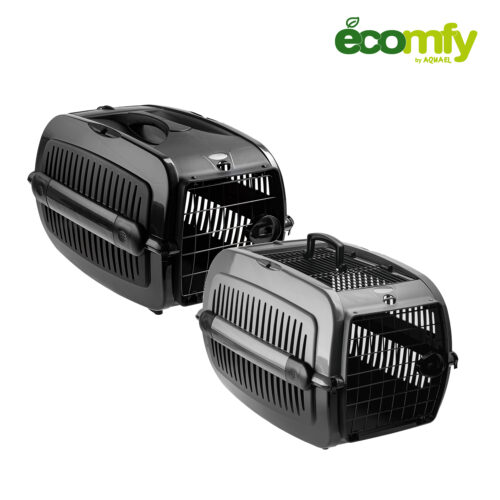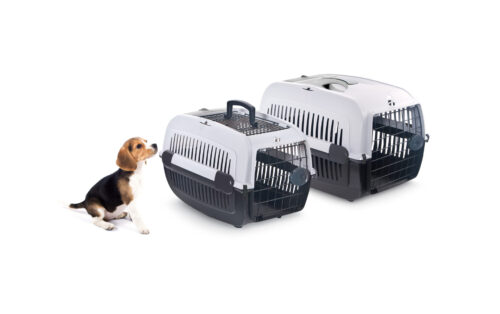





From time to time, all animals need to be transported, whether for visits to the vet, because the owners are moving, or simply for the pleasure of travelling with your pet.
You have two types of carriers to choose from – soft and hard. Soft carriers are best suited for small animals. Hard carriers are used for larger animals and for those which don’t like travelling.
What to keep in mind when choosing one?
Quality – the carrier for your furry friend should be durable. When choosing a soft carrier, you should pay attention to how the carrier was made. The stitching of the carrier should be strong, the zip and Velcro fasteners durable, and the safety mesh should be of good quality so that your pet can’t damage it.
Size – the carrier for your animal should be large enough for the pet to be able to easily come out and go in, sit down, lie down, and turn around. You must remember that when choosing a carrier for travelling by plane, first it’s necessary to check what requirements the airline has for the transporting of animals.
Handles and shoulder straps – the ease of carrying a cat or dog is another priority. As the name suggests, carriers are not only used to transport animals by car or plane, but also to carry them. When it comes to soft carriers, long shoulder straps are important to enable you to hang the carrier on your shoulder. If carried in hand, the handle should be strong and comfortable – this applies to both soft and hard carriers.
Remember that when travelling with your pet, it’s good to put in items that remind it of home and have a familiar smell. This will help to reduce stress. For the sake of your pet’s safety, place the carrier on the back seat of the car, or in the trunk provided that it’s easy to access. It’s a good idea to secure the carrier with a seat belt. If you decide to place the carrier on the front seat, make sure that the airbag is turned off. The airbag inflating can be highly dangerous to your pet.
Another way to secure your pet is to buy a special safety belt that can be attached to a harness. Such belts usually have adjustable length. A safety belt should never be attached to the collar because in case of unforeseen difficulties during the trip it could damage the animal’s vertebrae.
During a trip by car, remember to take breaks so that your pet can ‘go to the toilet’ as well as drink and eat something. Additional, equally important equipment for a travelling pet are poop bags, as well as a bottle and a bowl. When taking the pet out of the vehicle, make sure it has a collar or harness with a tag, and that the collar or harness are attached to a leash.
Speaking of harnesses.
As a pet owner, you have to think about what’s better for daily use – a collar or a harness. There are many opinions on this subject, but there’s no ideal recipe for which product is the best. There are many types of collars and harnesses. The choice depends on the size, temperament, breed, and activeness of your pet.
For the vast majority of dogs, a traditional collar and leash will be all you’ll need to ensure good control on walks and an ideal place for attaching the tag. Collars are usually adjustable, have a traditional or quick-release buckle, and are available in many colours, styles, and materials. Due to their durability, nylon or leather will be the best choice for everyday use.
Harnesses are ideal for small dogs, dogs with special needs, breeds susceptible to problems with their upper airways, or dogs suffering from a collapsing trachea. A harness can be a great solution when you want to do physical activities with your pet such as jogging, rollerblading, or cycling.
How to choose the right size of a collar or harness? First of all, you need to measure your dog. When choosing a collar, measure the neck circumference. The easiest way to choose the right size collar is to do so based on the so-called two finger rule. Place two fingers between the collar and the neck. The fingers should enter loosely and, at the same time, they should be touching the collar. When choosing a harness, you have to measure your pet too, but this time you measure the circumference of the chest just behind the dog’s front legs. The harness should be close-fitting, but not too tight.
When choosing collars, harnesses, and leashes, also remember to follow the manufacturer’s instructions. Each element is adapted to the size as well as the weight of your pet.
 LEO
pressure-free dog harness
LEO
pressure-free dog harness
 Cosmos Eco
eco-friendly carrier for pets
Cosmos Eco
eco-friendly carrier for pets
 COSMOS CLASSIC LINE
openwork walls and a wide entrance
COSMOS CLASSIC LINE
openwork walls and a wide entrance
Check where you can buy
our products
Map of stores